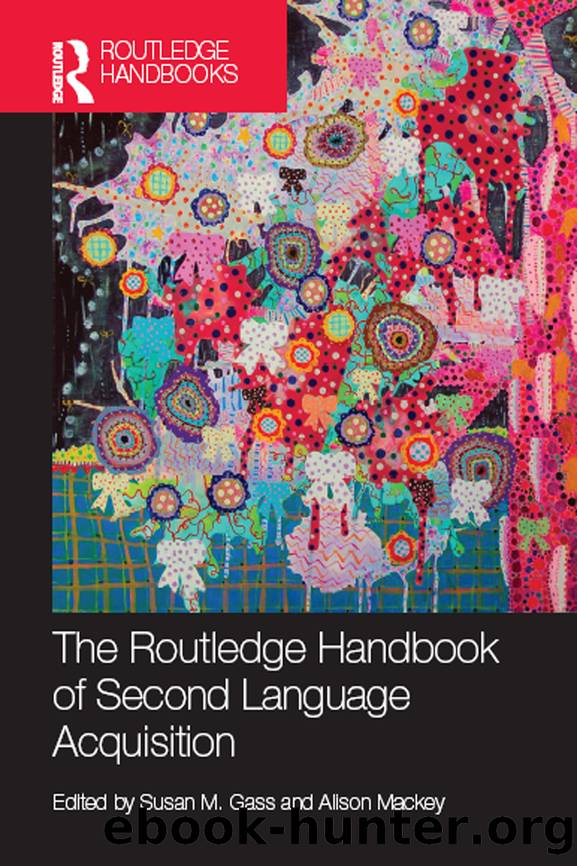The Routledge Handbook of Second Language Acquisition by Gass Susan M.; Mackey Alison; & Alison Mackey

Author:Gass, Susan M.; Mackey, Alison; & Alison Mackey
Language: eng
Format: epub
Publisher: Taylor and Francis
Part IV
Skill learning
18
Development of second language
reading skills
cross-linguistic perspectives
Keiko Koda
Introduction
Reading is a complex construct, involving multiple operations and a unique set of skills each of those operations entail. When learning to read occurs in a second language (L2), the complexity increases exponentially because each operation involves two languages (Koda, 2005). The primary objective of this chapter is to explore how the involvement of two languages affects L2 reading development. In probing highly complex issues, entailing multiple skills in multiple languages, it is important to clarify the basic assumptions underlying the conceptual explorations.
First, under the input driven view of learning (Ellis, 2002), learning—be it of language or reading—is regarded as the process of detecting, abstracting, and internalizing regularly co-occurring elements in input as corresponding units. Learning is achieved primarily through cumulative experience of mapping between corresponding elements. The more frequently particular patterns of mappings are experienced, the stronger the linkages holding them together. Under this view, reading skills are seen as an outcome of cumulative experience of symbol-to-sound, as well as symbol-to-morpheme, mappings.
Next, from a developmental perspective, Perfetti and associates (Perfetti, 2003; Perfetti and Dunlap, 2008) regard reading as a dynamic pursuit embedded in two interrelated systems: a language and its writing system. Because no writing systems directly encode meaning independent of language, reading acquisition involves making links between the two systems. In learning to read, therefore, children must uncover how spoken language elements are mapped onto the graphic symbols that encode them. It is hardly accidental that reading instruction does not commence until children acquire sufficient spoken language competence. Reading development thus necessitates substantial linguistic knowledge.
Transfer has been a major theoretical concept in second language (L2) research. Studies have repeatedly shown that L2 learning is affected by previously acquired competencies. Based on this notion of transfer, L2 reading research generally assumes that L2 reading skills are shaped jointly by transferred first language (L1) skills, L2 linguistic knowledge and L2 print input. In this regard, L2 reading is cross-linguistic, entailing continual interaction and assimilation of L1 and L2 factors. Theories of L2 reading must explain how the involvement of two languages affects L2 reading development; how transferred L1 skills are assimilated in L2 reading; and how the resulting L2 skills vary across learners with diverse L1 backgrounds.
Download
This site does not store any files on its server. We only index and link to content provided by other sites. Please contact the content providers to delete copyright contents if any and email us, we'll remove relevant links or contents immediately.
Cecilia; Or, Memoirs of an Heiress — Volume 1 by Fanny Burney(32059)
Cecilia; Or, Memoirs of an Heiress — Volume 3 by Fanny Burney(31455)
Cecilia; Or, Memoirs of an Heiress — Volume 2 by Fanny Burney(31406)
The Lost Art of Listening by Michael P. Nichols(7159)
We Need to Talk by Celeste Headlee(5412)
Asking the Right Questions: A Guide to Critical Thinking by M. Neil Browne & Stuart M. Keeley(5355)
On Writing A Memoir of the Craft by Stephen King(4661)
Dialogue by Robert McKee(4160)
Pre-Suasion: A Revolutionary Way to Influence and Persuade by Robert Cialdini(3975)
I Have Something to Say: Mastering the Art of Public Speaking in an Age of Disconnection by John Bowe(3775)
Elements of Style 2017 by Richard De A'Morelli(3235)
The Book of Human Emotions by Tiffany Watt Smith(3138)
Fluent Forever: How to Learn Any Language Fast and Never Forget It by Gabriel Wyner(2915)
Name Book, The: Over 10,000 Names--Their Meanings, Origins, and Spiritual Significance by Astoria Dorothy(2836)
Good Humor, Bad Taste: A Sociology of the Joke by Kuipers Giselinde(2825)
Why I Write by George Orwell(2773)
The Grammaring Guide to English Grammar with Exercises by Péter Simon(2646)
The Art Of Deception by Kevin Mitnick(2622)
Don't Sleep, There Are Snakes by Daniel L. Everett(2499)
